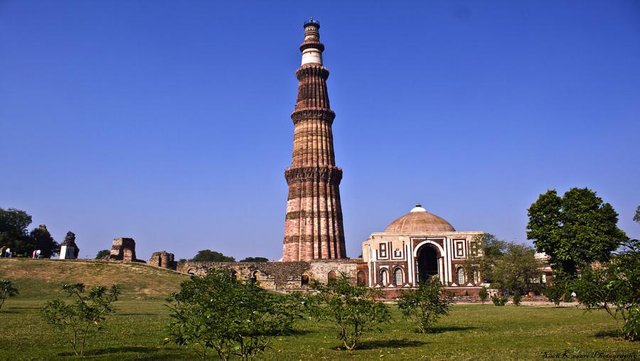Historically, the Indian subcontinent is unique in terms of architecture. The unimportant architectural patterns in the country, in different parts of the country, are still standing high on the streets by the streets. Kutub Minar, one of India's most famous architectural structures, is the Kutub Minar.
Kutub Minar is a pillar or a tower in India, which is the world's tallest brick tower. It is located in Kutub Complex, the Kutub Complex and the Minar with the ruins of ancient Hindu temples were built. The height of this tower, set in red sandstone, is 72.5 meters (238 feet). The minaret foot diameter is 14.32 meters (47 feet) and the diameter of the diameter is 2.75 meters (9 feet). At the beginning of the 18th century, the minarets were completed. The Alai Gate (1311), Alai Minar (It is a stack of unfinished minarets, but it is not finished), Quwat-ul-Islam Mosque (one of the earliest mosques in India, which is in existence), the tomb of Iltutmis and a iron pillar.It is said that this monastery is destroyed from the ruins of several Hindu and Jain temples. It is estimated that these temples were destroyed in the form of external accusations in the beginning of the rule of Islam in India. The purple shopping center is 7.02 meters (23 feet) in height, where there is a lighthouse, which is not present for a little bit of rust. There is a text of the second Chandagagupta in Sanskrit language on this iron pillar. In the year 1192, Qutbuddin Abiq started the mission of this monastery. During the reign of Iltatimas (1211-38) minarear was finished. During the reign of Alauddin Khilji (1296-1316) the construction of its premises and construction was completed. During the subsequent years, the minar was damaged due to bad weather, although it was renovated. There are several other ancient and medieval structures and ruins surrounding it, which are known together as Qutb complex. In the UNESCO World Heritage List (iv) division of this premises, as a distinct reflection of the Islamic architecture and art, the premises has earned the prestige of the World Heritage Site. It is one of the most popular tourist destinations in Delhi and it was the highest visited monument in 2006, and the number of tourists was 38.95 lakhs, more than the Taj Mahal, where Taj Mahal's tourism number was 25.4 lakhs.
It is built in imitation of the Afghan monastery in Afghanistan. The floor of the five-storeyed tower has a balcony or hanging verandah. There are two opinions on the name of the Qutub Minar, firstly its name is named after its creator Kutub Uddin Aibek. Secondly, it was built in honor of the famous Sufi saint Hazrat Qutb Uddin Bakhtiar Kaki, who came from Transaxiana.The Qutub Minar is made up of various tubular shafts separated by the verandah. The minaret is made of red sandstone, covering the verse of the holy Qur'an on it. There are some damage to the tower due to earthquake and thunderstorm but it is again fixed by the rulers.
During the reign of Firoz Shah, the two top floors of the tower were damaged by lightning, but it was amended by Firoz Shah. In 1505 the earthquake was destroyed and Sikandar Lodhi was revised. There is a 25-inch shield from the south-west of Qutub Minar which is considered "safe". A beautiful complex is surrounded by the Kutub Minar. The complex, situated on 100 acres of land, consists of the Kuwatul Islam Mosque, Alai Minar, Alai Gate, Sultan Iltutmish, Sultan Ghias Uddin Balban, Sultan Alauddin Khalji and Imam Zamin's grave and iron pillar.
Besides, the wall of the tower is decorated with various decorations. In the year 1193, the first Muslim ruler of India, Sultan Qutub Uddin started the construction of Abeb Qutb Minar. The 1st and 2nd floors were built under his supervision. Later (1211-36), the third and fourth floor of the tower under the direct supervision of Sultan Shamsuddin Iltutmish and the end of the 5th floor building was completed in the hands of Sultan Firoz Shah Tughlaq.
Historians are of the opinion that the Kutub Minar was used to offer the call for the convenience of the devotees of Quwatul Islam Mosque. Azan from the 1st floor was given regularity. Due to its high altitude, it is useful to use it as a security observation tower.